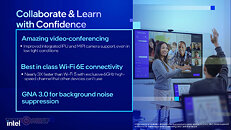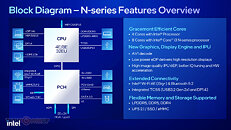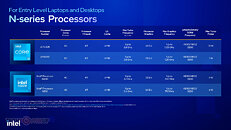- Joined
- Oct 9, 2007
- Messages
- 47,579 (7.46/day)
- Location
- Dublin, Ireland
| System Name | RBMK-1000 |
|---|---|
| Processor | AMD Ryzen 7 5700G |
| Motherboard | ASUS ROG Strix B450-E Gaming |
| Cooling | DeepCool Gammax L240 V2 |
| Memory | 2x 8GB G.Skill Sniper X |
| Video Card(s) | Palit GeForce RTX 2080 SUPER GameRock |
| Storage | Western Digital Black NVMe 512GB |
| Display(s) | BenQ 1440p 60 Hz 27-inch |
| Case | Corsair Carbide 100R |
| Audio Device(s) | ASUS SupremeFX S1220A |
| Power Supply | Cooler Master MWE Gold 650W |
| Mouse | ASUS ROG Strix Impact |
| Keyboard | Gamdias Hermes E2 |
| Software | Windows 11 Pro |
Intel today debuted its 2023 N-series entry-level mobile processors targeting a range of low-cost notebook applications, such as educational notebooks for bulk purchase and distribution by public schools. These processors are built on the same Intel 7 (10 nm Enhanced SuperFin) node as the 13th Gen Core processors, but come with just "Gracemont" E-cores, and no P-cores.
The silicon physically features two "Gracemont" E-core clusters amounting to 8 E-cores, 6 MB of shared L3 cache, and an iGPU based on the Xe-LP graphics architecture, with 32 EUs (execution units). The silicon also features a GNI 3.0 for basic AI acceleration using a truncated version of the DLBoost instruction set, and an IPU (as in image processing unit), which can improve web-camera experience (on the fly background noise suppression). The iGPU also offers hardware-accelerated AV1 decoding. On the platform-side, the processor features a single-channel DDR5 memory interface that's backwards-compatible with DDR4, and also supports LPDDR5. Storage interfaces include eMMC, UFS 2.1, and NVMe SSD. Wireless networking options available with the platform include fast WiFi 6E and Bluetooth 5.2.




There are two distinct brand extensions based on CPU core-counts, the Intel N100/N200-series, with just one E-core cluster enabled, amounting to 4 cores; and Core i3-N300 series, enabling both E-core clusters for 8 cores. The N100 and N200 chips have their TDP rated at just 6 W, while the Core i3-N300 series chips are either 7 W or 15 W, depending on the model.

View at TechPowerUp Main Site
The silicon physically features two "Gracemont" E-core clusters amounting to 8 E-cores, 6 MB of shared L3 cache, and an iGPU based on the Xe-LP graphics architecture, with 32 EUs (execution units). The silicon also features a GNI 3.0 for basic AI acceleration using a truncated version of the DLBoost instruction set, and an IPU (as in image processing unit), which can improve web-camera experience (on the fly background noise suppression). The iGPU also offers hardware-accelerated AV1 decoding. On the platform-side, the processor features a single-channel DDR5 memory interface that's backwards-compatible with DDR4, and also supports LPDDR5. Storage interfaces include eMMC, UFS 2.1, and NVMe SSD. Wireless networking options available with the platform include fast WiFi 6E and Bluetooth 5.2.




There are two distinct brand extensions based on CPU core-counts, the Intel N100/N200-series, with just one E-core cluster enabled, amounting to 4 cores; and Core i3-N300 series, enabling both E-core clusters for 8 cores. The N100 and N200 chips have their TDP rated at just 6 W, while the Core i3-N300 series chips are either 7 W or 15 W, depending on the model.

View at TechPowerUp Main Site







